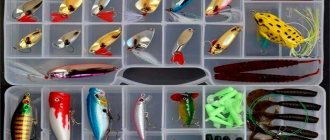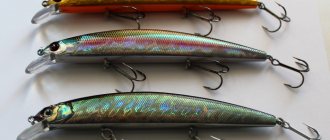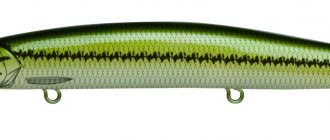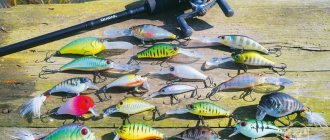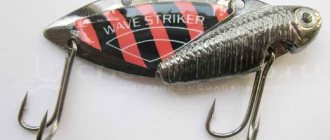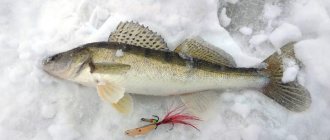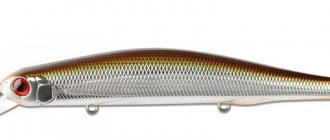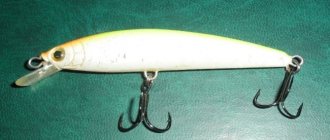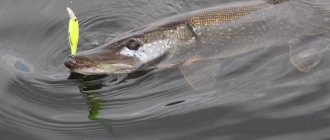Twitching wiring technique
The basis of the wobbler twitching technique is to perform spinning jerks. The effectiveness of fishing, as already mentioned, directly depends on which twitching technique is chosen.
There are several types of twitching wiring:
- aggressive twitching;
- monotonous (classic) twitching;
- slow (dying) twitching;
- rhythmic twitching;
- chaotic twitching;
- twitching Stop and go.
It is not difficult to guess that monotonous retrieving involves smoothly holding the bait under water, rhythmic retrieving is performed rhythmically, with jerks of equal strength, between which equal pauses are maintained, while chaotic retrieving is performed with different jerks, the pauses between which are also different.
The twitching technique of inserting a wobbler is used more often for catching perch and spotted predator – pike. To catch perch, anglers recommend making sharp jerks , between which, in turn, it is recommended to take short pauses. As for pike, it doesn’t like it when the bait lingers in front of its eyes for a long time. She can leave. Therefore, when catching pike, you should not take long pauses; it is better to perform jerks at intervals of no more than five seconds .
Pumping
A mirror version of ripping is pumping, in which the movement of the rod is directed upward. As the name implies, the wiring technique is similar to the actions when landing fish - alternating raising and lowering the rod in combination with a uniform retrieve.
The movements of the bait are smoother than when twitching, since at the moment of acceleration the wobbler tends to go deeper under the influence of water on the blade, and the rod pulls it in the opposite direction. This wiring is especially effective when using sinking wobblers.
Read more
How to equip a spinning rod
Movements when ripping are carried out from top to bottom
Aggressive twitching
Aggressive twitching is akin to chaotic twitching. To properly fish by twitching - twitching, you need to perform aggressive twitching rather quickly with strong, sharp jerks. This type of twitching involves inserting, as a rule, wobblers, using high-speed tempos. In order to perform this type of fishing, you should choose minou class wobblers as equipment. Spinning rods should be chosen with Extra-Fast action.
We also recommend reading:
Budget spinning reels Riobi Exiya Model range of Salmo wobblers and the Salmo Hornet catalog Features of fishing with a retractable leash, selection of gear and installation Aiko spinning rods (Aiko): catalog, features
Using an aggressive type of twitching, along with short jerks and short pauses, you can continue to drive the wobbler monotonously and measuredly. Anglers who are knowledgeable about aggressive twitching using floating wobblers for this type of fishing, which are distinguished by the fact that they float up slowly. If the fisherman does not have floating wobblers, you can use wobblers that have high persistence rates. This bait is highly resistant to jerking .
Monotonous twitching
Monotonous twitching is also called classic twitching . It involves monotonous wiring of the wobbler. In other words, monotonous wiring of the wobbler is performed at a moderate (average) pace. When performing such wiring, it is recommended to make two or three jerks of medium amplitude with pauses of two to three seconds.
For monotonous twitching, wobblers that have low persistence rates . Their length should be about ten centimeters. The buoyancy of such a wobbler must correspond to the SP class, which indicates that wobblers of this class float up slowly. As for the spinning rod that should be chosen for this type of fishing, a spinning rod with a Regular-Fast action is quite suitable.
Monotonous twitching wiring can be used at any time of the year . That is why this type of twitching has a second name - classic twitching.
Uniform
This is the basic bait presentation technique with which an angler begins to master wobbler fishing. It is relatively simple, suitable for most classes of bulky solid baits. Uniform wiring of the wobbler is performed as follows:
- The fisherman casts the bait to a given point.
- After splashdown, the coil arm closes.
- Then the wiring is carried out by monotonously rotating the reel handle at a given speed.
Even fishing is often done with cranks and rattles. For these baits, monotonous feeding is the main one. The fisherman can only vary the speed of reeling in the fishing line, choosing the one that best suits the mood of the predator.
Many shad models operate on a uniform retrieve. For certain versions of decoys this may be the basic animation. Not everyone is comfortable with the monotonous presentation of Minnow. This animation is only suitable for those wobblers that have their own game.
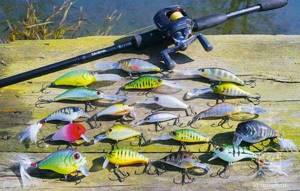
Cranks are the best baits for uniform retrieval
From topwaters, uniform wiring is applied to propbaits. Some poppers also allow for monotonous delivery. For example, the famous Malas from Lucky Craft with this method of animation begins to work like a subsurface wobbler, diving 10–20 cm, swinging from side to side and making appetizing medium-amplitude movements.
Chub, trout, dace, grayling, perch, asp, ide, rudd, sabrefish, pike and other representatives of the ichthyofauna love uniform animation. In fact, this method of feeding a wobbler allows you to fish in any body of water, regardless of its size, depth in the fishing zone, strength of the current and other factors.
Slow (dying) twitching
Slow twitching, also known as dying twitching, is performed slowly, at slow wiring speeds. This type of twitching means that it is accompanied by several jerks with a long pause of about 10 seconds. It's a good idea to diversify the slow wiring with some randomness of actions . This often helps attract the attention of predatory fish to the bait.
This type of twitching might look like this:
- two jerks, pause;
- five jerks, pause;
- long jerk, pause.
Then the cycle repeats.
complete freedom of action in slow twitching . You can show all your creative abilities. Using slow twitching, it is best to catch predatory fish at times when the water is cold. This could be early spring or late autumn.
Wobblers with medium buoyancy are suitable for this fishing method. Spinning rods can be chosen with different formations . Both Extra-Fast and Regular-Fast tunings will work.
The important role of pause
In most cases, moving baits with a stop and then a pause is more effective. In this case, the pause should be from one to several seconds. A pause that is too short and unexpressed is more likely to arouse the suspicion of a predatory fish rather than provoke it to bite.
Read more
Which reel to choose for a float fishing rod?
In addition to the fact that stopping the wobbler diversifies its animation, a pause in the retrieve allows you to control the bait, changing the horizon of the retrieve, and when retrieving across the current, you can draw the wobbler around obstacles.
Rhythmic twitching
The rhythmic type of twitching is similar to the monotonous type, but differs in that jerks of the spinning rod are performed without pauses. Several jerks are made without pauses, then a pause and the cycle repeats. The main feature of this type of wobbler wiring is that, depending on the twitching activity, the fisherman can choose between the duration of pauses and the strength of jerks. This is not critical in the sense that the fish will attack the bait in any case . Rhythmic twitching is performed from a series of monotonous wiring, between which a large jerk is made over the entire length.
Chaotic twitching
The reader may associate chaotic twitching with an aggressive type of wobbler wiring, but this is not so. The chaotic type of twitching differs from the aggressive one in that it is performed using all types of twitching at the same time . That is, with such twitching, all known types of wobbler wiring alternate sequentially or, again, chaotically.
Fishermen use the chaotic twitching method most often to catch predators such as pike. It is better to choose the summer time of year for this type of fishing.
The main feature of chaotic twitching is that, unlike aggressive twitching, it should be performed as chaotically as possible . That is, all jerks and pauses must be different from each other.
Wiring for the outlet leash
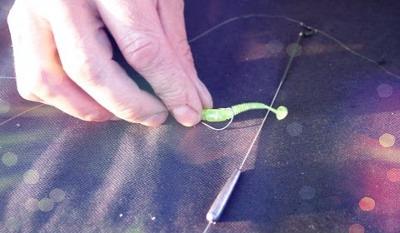
When fishing with a retractable leash, the following are most often used:
- classic stepped wiring;
- wiring for demolition.
In addition, when fishing with this rig, you can play with the bait at one point for a long time: after the weight drops to the bottom, the angler performs various swings and pulls with the tip of the spinning rod, “revitalizing” the bait. The load remains motionless. This technique is well suited for spot fishing of promising areas and perfectly attracts a passive predator. Features of wiring for different types of fish
However, when fishing, situations often happen when, for example, an angler who is aiming to catch a small pike in the coastal zone begins to receive one perch bite after another, or a spinner who was going to catch a perch on the edge suddenly pulls out several one after another. pike perch.
Using these basic spinning techniques, you can achieve good results in catching predators in any conditions. But we should not forget that in order to achieve a truly high level of fishing skill, constant searches and experiments are necessary - only this will allow you to comprehend all the intricacies of fishing science, get real pleasure from being on the reservoir and always end up with a good catch.
In conclusion, we present to your attention a video that clearly demonstrates the knowledge gained. Enjoy watching!
Source: fishcave.ru
Stop and Go Wiring
This type of twitching is used for pike hunting and consists in the fact that it is used when the pike is “in a bad mood,” that is, inactive. When other types of twitching, with the help of which anglers catch such a predator as pike, are not suitable and do not bring a positive result, then a special method of guiding a wobbler is used, which is called Stop and Go. Such twitching is carried out through a series of slow postings, alternating with fast postings. Such wiring can be done either by jerking the spinning rod or using a reel.
Stop and Go posting is carried out as follows:
- three or four slow turns of the coil;
- pause about 3 seconds;
- light jerk of the spinning rod.
The last stage - a light jerk of the spinning rod should be so light that the wobbler does not work in the usual sense of the word, but barely rolls from side to side.
Then the cycle repeats.
Correct twitching technique / How to catch new wobblers for pike?
Late autumn is pike time. In many bodies of water, as the water gets colder, the toothy fish become more active and begin to feed heavily. But as always, on any body of water, the main task is to find an active predator. For me personally, the most effective and fastest way to search is twitching. Wobblers attract pike from a great distance, both with sound vibrations and visually. Therefore, we can conditionally divide wobblers for twitching into noise and silent ones. I personally, in most cases, like to fish with noise lures, since I believe that they are more suitable for searching for active pike. But in cases where the fish is passive, or it is necessary to catch the fish after a single bite, I often install a silent wobbler and make a more passive retrieve. This technique often helps.
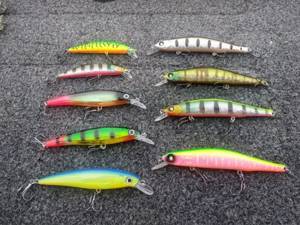
More and more videos are appearing about the top wobblers, but mostly these are models that have been around for a long time and many copies and analogues have been made from them, but how to catch new wobblers and new colors? Especially when they are far from Japanese
Now for the wiring. It is quite difficult to describe in words the wiring of a wobbler, especially since each fisherman has his own views on what kind of wiring a particular wobbler should have, which is correct and which is not. I believe that when describing the wiring of a twitch wobbler, they can be divided into two types: active wiring and passive. Personally, I prefer to use active wiring to find pike. When the jerks and blows of the wobbler are sharp enough, the number of jerks can reach 3-5 per series, and the pauses are very short. Such wiring does not take much time, allows you to quickly fish the water area, and allows you to quickly determine the presence of an active predator. But, if there are contacts with fish, but bites cannot be realized, then it’s time for experiments.
First of all, you should change the wiring to a more passive one, that is, make less sharp jerks with the wobbler and be sure to increase the length of the pause between jerks. Pauses, by the way, are generally the main element in wiring a wobbler. It is necessary to experiment with the length of the pause directly on each fishing trip, since in each specific case its length may vary. The same goes for the color of the wobbler. Personally, I think color matters. I have wobblers in a wide variety of colors in my collection. And on each body of water the color of the wobbler needs to be selected. Although, in principle, when a pike eats, it doesn’t care about the color and size of the wobbler. As for the size of the bait, not everything is so simple here either. You also need to have wobblers of different lengths in your arsenal; as a rule, for pike fishing these are sizes from 90 to 160 mm, but the main ones, of course, are 110-130 mm. As a rule, we use the largest wobblers either at the beginning of summer, in the first few weeks after the opening of the boating season, or already in the fall, when the water gets colder, when pike prefer larger baits. In general, if we briefly summarize all of the above, we can draw two conclusions. First: you should have a variety of wobblers in your arsenal. This does not mean that you should have a hundred other expensive baits, far from it. But a certain set of different sizes and colors should be in your arsenal. And second: you constantly need to experiment and actively change baits. This is the only way to quickly select the optimal wobbler in a given location and under given fishing conditions. Arriving at a reservoir, we do not know what mood the predator is in and whether it is in the mood to feed. Therefore, only an active change of bait can quickly lead to a positive result.

And finally, I would like to note a point that fishermen constantly argue about. Which wobbler is better to buy: an expensive original, or a budget analogue, of which you can buy two or even three for the same money. My opinion is this. At the moment, many manufacturing companies originally from the Middle Kingdom have learned to make fairly high-quality products. And the wobblers of these companies catch fish no worse than their Japanese originals. The main thing is to devote some time to each wobbler that ends up in your box and understand how it plays and how to catch it. Then it will bring bites and will delight you with catching fish, and will not lie as ballast in the box and you will not regret wasting money.
We went fishing to test the new colors of Akara Arrow, Best Minnow, Jockey and Splinter wobblers. We’ll tell you in detail how to catch new wobblers for pike even when the fish doesn’t want to bite! Search tactics and the right twitching technique will definitely bring results! Fishing in the fall with a spinning rod on one of the most fishing places in Belarus - Lake Selyava. Our online store in Belarus: lovisnami.by/ We are on VKontakte Fishing in Belarus: vk.com/fishing47 We are on Instagram: instagram.com/lovisnami__by/ #fishing #spinning #twitching
